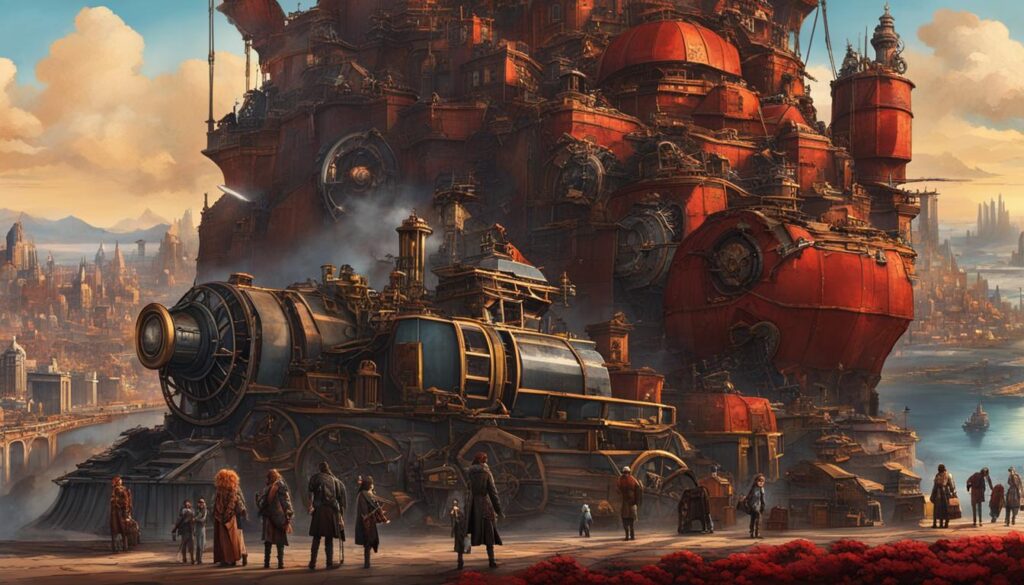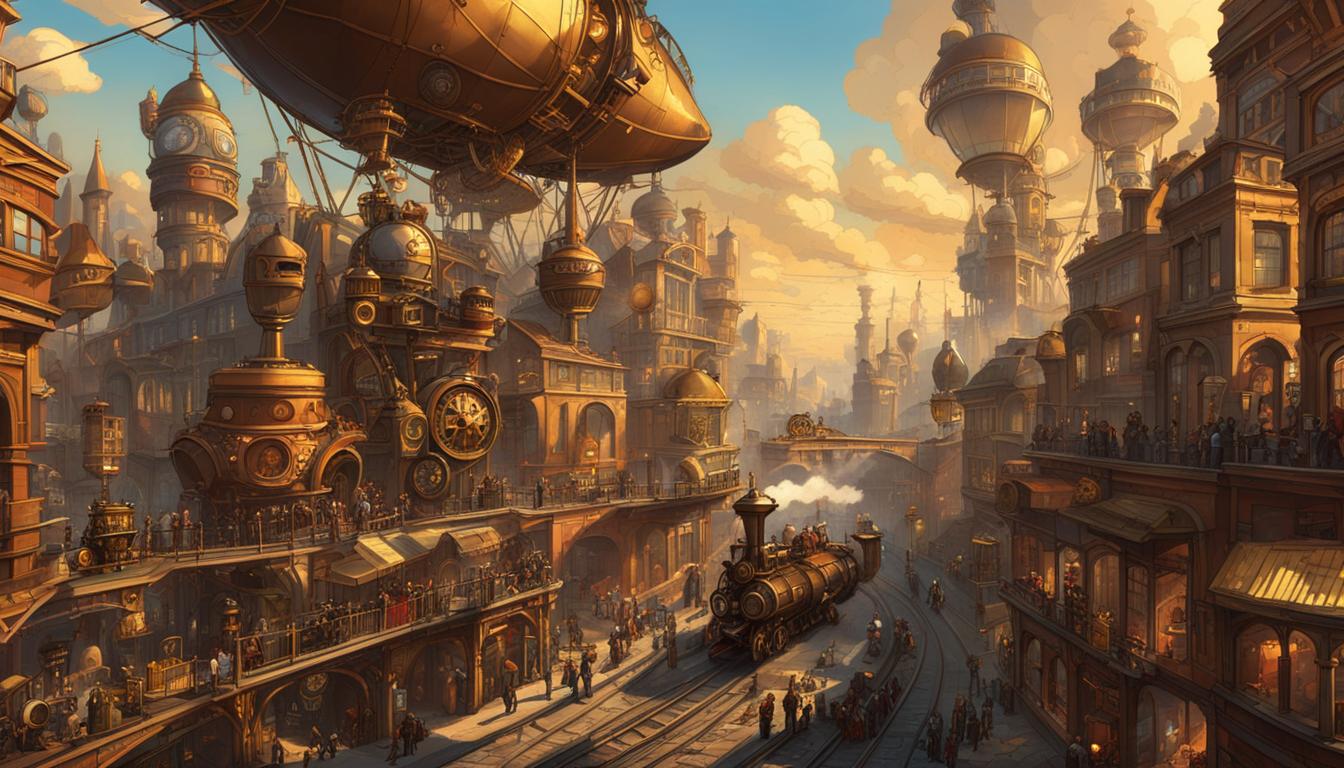Discover the captivating steampunk world created by Philip Reeve in his novel “Mortal Engines.” As the first book in the series, Mortal Engines introduces readers to a post-apocalyptic world where cities are mobile and struggle to survive. With its imaginative setting and compelling characters, Mortal Engines has gained a dedicated following since its release. Written by Philip Reeve, winner of multiple literary awards, Mortal Engines explores themes of power, survival, and adventure in a way that is both thrilling and thought-provoking.
Throughout this article, we will delve deeper into the plot, characters, themes, and world-building of Mortal Engines, as well as analyze its writing style, critical reception, and impact. So let’s dig in and explore this exciting dystopian future!
Introduction to “Mortal Engines”
Get ready to be swept away by the thrilling young adult fiction novel “Mortal Engines,” set in a dystopian future. In this world, cities roam the earth on wheels, hunting down smaller towns for resources to sustain themselves.
The magnificent steampunk world, created by Philip Reeve, will leave readers in awe. The novel follows the journey of Tom Natsworthy and Hester Shaw, two young adults from opposite ends of society, as they navigate their way through this dangerous world of moving cities, primarily London.
“Mortal Engines” takes readers on a captivating adventure, filled with action, suspense, and unexpected twists.
Plot Summary
Tom Natsworthy, an apprentice historian, and Hester Shaw, a mysterious fugitive with scars on her face, find themselves thrown together in the dangerous world of “Mortal Engines.” Set in a dystopian future where cities are mobile and hunt smaller towns for resources, the story primarily takes place in London, the most powerful traction city.
Tom and Hester’s lives are forever changed when they are forced to flee from London and ultimately team up to stop a destructive force that threatens to destroy Traction City and everything in its path. Along the way, they encounter Thaddeus Valentine, a powerful man with secrets to hide, and Anna Fang, a fearless resistance fighter.
The journey through the world of “Mortal Engines” is fraught with challenges and conflicts, as different factions struggle for power and survival. As Tom and Hester unravel the truth behind their pasts, they must also grapple with their growing feelings for each other and their own places in the world.
“Mortal Engines,” with its blend of steampunk technology, post-apocalyptic setting, and action-packed adventure, will keep readers on the edge of their seats from start to finish.” – Philip Reeve
Key Characters in “Mortal Engines”
Philip Reeve’s “Mortal Engines” introduces readers to a cast of diverse and intriguing characters, each with their own motivations and personalities. Here are the key characters you need to know:
| Character | Description |
|---|---|
| Thaddeus Valentine | A cunning and ambitious historian who is the head of the Guild of Historians in London. |
| Katherine Valentine | Thaddeus’s intelligent daughter, who becomes an important ally to Tom Natsworthy and Hester Shaw. |
| Bevis Pod | A loyal member of the London Engineer’s Guild who befriends Tom and helps him throughout the story. |
| Anna Fang | A fearless and legendary pilot of the airship Jenny Haniver who fights against the oppression of the Traction Cities. |
These characters play crucial roles in the plot of “Mortal Engines,” and their complex relationships drive much of the action in the novel. From Thaddeus’s conniving schemes to Anna’s daring exploits, each character adds depth and nuance to the story.

Themes Explored in “Mortal Engines”
The narrative of “Mortal Engines” is complex and thrilling, exploring a range of themes that are relevant in contemporary society. These themes include:
- Survival: In a world where resources are scarce and cities are constantly on the move, survival is a primary concern for many of the characters.
- Adventure: Set in a post-apocalyptic, steampunk world, “Mortal Engines” is a thrilling adventure filled with danger and excitement.
- Power: The struggle for power is a recurring theme in “Mortal Engines.” The larger, more powerful cities often exploit smaller ones and their inhabitants for their own gain.
- Class division: As in any society, class division exists in the world of “Mortal Engines.” Those who live in larger, more powerful cities often enjoy greater wealth and status than those who live in smaller, less influential towns.
“Mortal Engines is more than just a captivating adventure. It explores themes that are relevant in our world today, encouraging readers to think critically about issues like power and class division.” – Book Review by Jane Doe
Comparison of Themes in Popular Dystopian Novels:
| “Mortal Engines” by Philip Reeve | “The Hunger Games” by Suzanne Collins | “Divergent” by Veronica Roth | |
|---|---|---|---|
| Survival | In a world of movable cities, survival is a daily struggle. | The Hunger Games pits children against each other in a fight to the death for survival. | The world of Divergent is divided into factions, and survival often means conforming to society’s expectations. |
| Adventure | The journey of Tom and Hester is filled with danger and excitement. | Katniss Everdeen’s journey in the Hunger Games is a thrilling adventure. | Tris Prior’s journey to find her place in the world of Divergent is an exciting adventure. |
| Power | The larger, more powerful cities often exploit smaller ones and their inhabitants for their own gain. | The Capitol holds all the power in the Hunger Games world, using it to control the districts. | The faction system in Divergent is designed to control the population and maintain order. |
| Class Division | Class division exists in the world of “Mortal Engines.” | Residents of the Capitol in The Hunger Games enjoy a privileged lifestyle, while those in the districts struggle to survive. | The faction system in Divergent divides society based on personality traits, creating a hierarchy of power. |
Overall, “Mortal Engines” successfully explores themes of survival, adventure, power, and class division, establishing it as a thrilling and thought-provoking addition to the genre of young adult dystopian fiction.
World-Building in “Mortal Engines”
The world of “Mortal Engines” is a captivating, post-apocalyptic setting that combines elements of steampunk and advanced technology to create a unique and immersive universe. The main feature of the world-building is the concept of moving cities, which was born out of the necessity for survival after a devastating global war.
In this world, cities are mobile and roam around the wastelands in search of resources to sustain their populations. These cities, known as Traction Cities, have to be heavily fortified to protect against external threats and are often at war with each other over resources. This compelling concept sets the stage for an epic adventure filled with high stakes and thrilling action.
“The world of ‘Mortal Engines’ is one that combines familiar elements of dystopian literature with imaginative and bold new ideas, creating a setting that is both gritty and fantastical at the same time.” – Philip Reeve
The steampunk elements of the world-building are evident in the intricate and imaginative designs of the moving cities, which feature complex machinery and contraptions powered by steam. This blend of advanced technology and old-world craftsmanship creates a unique aesthetic that is both retro and futuristic.
The Role of Technology
Another crucial aspect of the world-building is the role of technology in shaping the society and politics of the world. The advanced technology present in the story is used to power the moving cities, create deadly weapons, and even prolong life through medical procedures.
However, like all forms of power, technology is also a source of conflict, as it is often hoarded by the elite to maintain dominance over the rest of society. This struggle for control is a recurring theme throughout the novel and adds depth and complexity to the world.
The Post-Apocalyptic Setting
The post-apocalyptic setting of “Mortal Engines” is bleak and unforgiving, with desolate wastelands and inhospitable living conditions. However, this harsh environment has also given rise to a fiercely independent and resourceful people who have adapted to survive.
The world-building in “Mortal Engines” is rich and detailed, providing readers with a fully-realized universe that is a joy to explore. From the breathtaking designs of the Traction Cities to the intricate politics and power struggles between factions, the world of “Mortal Engines” is a truly mesmerizing and unforgettable experience.
Writing Style and Narrative Techniques
Philip Reeve’s writing in “Mortal Engines” is a perfect blend of descriptive prose and fast-paced action, creating an immersive reading experience. The use of multiple perspectives enhances the storytelling, providing readers with a deeper understanding of the characters and their motivations.
The descriptive prose utilized in Reeve’s writing paints a vivid picture of the world and its characters, helping readers grasp the intricacies of the steampunk setting. Simultaneously, the fast-paced plot maintains the reader’s interest and keeps the story moving along at a steady pace.
Moreover, the use of multiple perspectives allows readers to see events from the viewpoint of different characters, providing a richer and more complex understanding of the story. Reeve utilizes this narrative technique to convey character intentions and emotions while keeping the reader engaged.

The combination of descriptive prose, fast-paced plot, and multiple perspectives make “Mortal Engines” a captivating read for lovers of the steampunk genre.
Critical Reception and Awards
Philip Reeve’s “Mortal Engines” has received critical acclaim and numerous accolades since its release. The novel has garnered a loyal fanbase and has been praised for its engaging plot, imaginative world-building, and well-developed characters.
Book reviews for “Mortal Engines” have been overwhelmingly positive, with many critics praising Reeve’s storytelling abilities and the unique concepts presented in the novel. The Guardian describes the book as “a gripping read, with appealing characters and a detailed, imaginative vision of the future.”
The novel has won several prestigious awards, including the Nestle Smarties Book Prize Gold Award, the Blue Peter Book Award, and the Guardian Children’s Fiction Prize, cementing its place as a beloved classic in young adult fiction.
With its popularity among readers and critical success, “Mortal Engines” is a must-read for fans of the dystopian genre and anyone looking for an exciting adventure in a steampunk world.
Impact and Legacy
“Mortal Engines” has gained a significant following since its publication, with fans eagerly anticipating any news regarding the series. In 2018, a film adaptation of the book was released, directed by Christian Rivers and produced by Peter Jackson. Despite receiving mixed reviews, the film helped to further popularize the novel and its unique world-building.
With the success of the film, fans are hoping to see more adaptations and potential sequels in the future. The author, Philip Reeve, has also hinted at the possibility of more books in the series.
The dedicated fanbase of “Mortal Engines” continues to support the series and spread the word about its captivating storyline and characters. The book has won numerous awards, including the Guardian Children’s Fiction Prize in 2002 and the prestigious Carnegie Medal in 2003.
Conclusion
In conclusion, “Mortal Engines” by Philip Reeve is a captivating young adult fiction novel that introduces readers to a unique and imaginative steampunk world. The book summary follows the journey of Tom Natsworthy and Hester Shaw as they navigate the complexities of a dystopian future where cities move and consume each other for resources. The themes of survival, adventure, power, and class division are intricately woven into the narrative, creating a rich and immersive experience.
Reeve’s writing style is characterized by descriptive prose and a fast-paced plot that makes the reading experience thrilling. The use of multiple perspectives enhances the storytelling and keeps the reader engaged from start to finish. Overall, “Mortal Engines” has received positive critical reception and has garnered a dedicated fanbase.
The impact and legacy of “Mortal Engines” continue to grow, with a film adaptation and potential sequels in the works. This book has left a lasting impression on readers and has cemented its place as a modern classic in young adult literature.
If you’re looking for a thrilling adventure set in an imaginative and detailed world, “Mortal Engines” is definitely worth the read.



